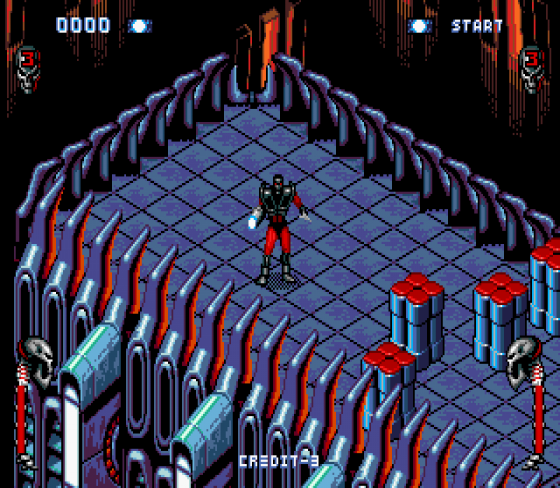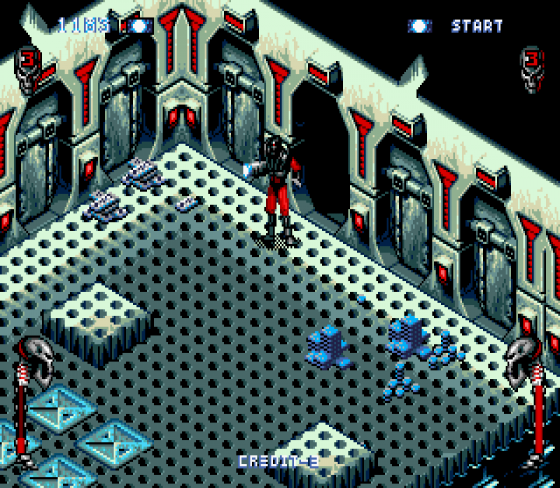
Mean Machines Sega
 1st March 1995
1st March 1995
Categories: Review: Software
Publisher: Core
Machine: Sega Mega Drive (EU Version)
Published in Mean Machines Sega #30
Skeleton Krew
Fate can be cruel. When given the name Shirley Crabtree, young Shirl had no choice but to stuff his face with pies until he became a big, wobbly wrestler and adopted the name Big Daddy. Conversely, when Damien Icouldaveyereasy was revealed to be a quiet chap, he duly changed his name to Russell Grant. What I'm saying is, basically, a dodgy name can determine a person's fate.
Take the bad guy in Core's newie, Skeleton Krew. With a name like Moribund Kadaver, he was bound to turn into an evil genetic scientist prone to engineering hideous mutants for his own use. I mean, what were his parents thinking of?
Needless to say, Kadaver's plans for mutant domination have got to be nipped in the bud, but rather than changing his name legally, Core are sending in the three gun-toting members of the titular Skeleton Krew to flush him out of his six-level domain.
Origin

Sort of like Battlecorps but viewed from the outside. And using sprites. Sort of.
Game Aim
Blast a path through the alien menace to the final boss, Krochnagara. Or whatever he's called.
Krew Kut
Skeleton Krew is best described as a mixture of Gauntlet, Battlecorp and Viewpoint. It takes place over six scrolling isometric stages, with the player and their optional mate guiding one of three cyborgs through squads of enemy droids and gadgets. Starting the game, three characters are proferred, offering the player a choice of fast but weak hero, an armoured but slow one, and a 'pretty average actually' one.

The six stages are spread across four worlds, and begins within an Earth city before moving on to the sewers, and on to Mars and its mines, the dumping ground on Venus, and Kadaver's mutant base. Each area is crawling with a mixture of mutant targets and bosses, and the basic aim is to blast a way through them whilst simultaneously collecting coins and extra lives along the way. Simple, really.
Come And Have A Go
Skeleton Krew's method for multi-directional blasting is akin to that of Battlecorp. Each of the warrior machines is armed with an unlimited supply of mines and lasers, and switching between the two is effected using the A button. As with big clunky tanks, the sprites fire in the direction they are facing, yet using the A and C buttons in conjunction with the B button makes their top half rotate in the required direction, allowing the player to take aim and fire.
This versatility also spreads to the device's motive units which in addition to moving in the customary eight directions can be made to jump (well, skip) by tapping the C button.
Money For Nothing

Money makes the world go around, the world go around, the world go around as they say, and it certainly enriches the Skeleton Krew's lives. Dotted around the play area are numerous piles of coins and notes which come in three colours.
The lowest denomination are blue which aren't worth the paper they're printed on, but the red and white piles are far more valuable. 10,000 NuBucks (as they're known) garner and extra life, but 1-UP icons can also be found around the place.
Gus
The first few plays of this seduced me into thinking I was in the presence of a classic in the making. Sadly, Skeleton Krew ends up being merely above average because of a few basic faults.

It looks great, and the fast-moving isometric layouts are something entirely new. But the repetitive levels really need some variety or depth to give you a boost once in a while instead.
But although it gets more frenetic, nothing significantly new comes along. However, the engine itself has distinct possibilities.
Steve
Skeleton Krew tries a new slant on the blasting theme by incorporating a novel control system and the rarely used isometric perspective. In terms of initial appeal, this works perfectly, with the three control buttons used to superb effect as the player wanders around busy and intricately-drawn backdrops.

However, the robots themselves are a little cumbersome, even the fastest. The number of aliens are often excessive, making successful manoeuvring and accurate firing almost impossible, and loss of life seemingly inevitable.
If it wasn't for this overhead difficulty setting, I wouldn't hesitate to recommend this. The rotational control method allows for complete control, and all praise to the programmers for achieving this, but even the most adept player is going to find the continual barrage of alien fire a little trying: A real pity, as the basic idea and game is sound enough.
It's a little like painting the Mona Lisa, and adding a beard to her.
Verdict

Graphics 83%
P. Incredibly detailed backdrops and loads of attractive aliens - perhaps a little too many at times!
N. The sacrifice of colour for detail is painfully apparent.
Sound 91%
P. Nice introductory music and the game effects are everything a trigger-happy so-and-so could want. Typical Core polish.
Playability 84%
P. Control is a delight to use, and the levels are large and stacked with hidden stages.
N. Too intense at times, making it impossible to avoid death.

Lastability 80%
P. Six larger levels, and Core have certainly made sure it's tough.
N. Whilst we appreciate games shouldn't be a walkover, this takes it too far...
Value For Money 83%
An average price for a very tough blast. It does offer a challenge, but is only recommended if you are extremely tolerant of no-win situations.
Overall 83%
Superb in every aspect, but progress is restricted by an overhard difficulty level which makes it hard to progress. Frustrating, and only recommended for those with plenty of hair to pull out.
Scores
Sega Mega Drive Version| Graphics | 83% |
| Sound | 91% |
| Playability | 84% |
| Lastability | 80% |
| Value For Money | 83% |
| Overall | 83% |














